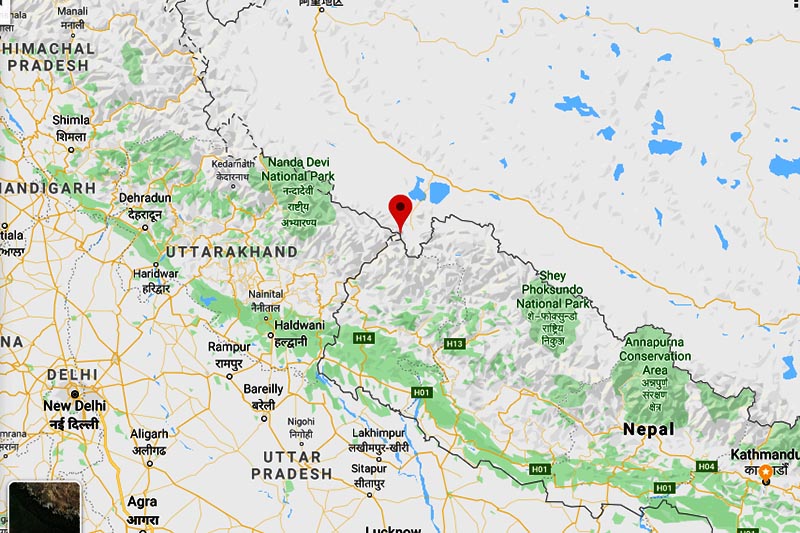Armed Police Force increases presence in Kalapani area
Kathmandu, June 15
Armed Police Force has increased its presence with regular patrolling in the Kalapani area.
The area, which serves as tri-junction of Nepal, India and China is of strategic importance and now has started witnessing on-site patrolling on a regular basis as a measure to increase the state's presence.
Earlier, the APF's Border Outpost was established at Chhangru (Gaga) of Byas Rural Municipality in Darchula.
Since then, the security force from the same post have been patrolling the area regularly after reaching the Seto Pul (White Bridge) of Kalapani which lies some 14 kilometres away from Chhangru.
Chhangru is 80 kilometres away from Khalanga, the district headquarters of Darchula, and Gunji Dhobhan is situated at a distance of 10 kilometres from Chhangru. Likpulekh is 17 kilometres away from Gunji.
The government has already issued the country's revised political and administrative map, which shows Kalapani, Lipulekh and Limpiyadhura within its boundary. These territories were encroached by India.
The Constitution Amendment Bill aiming to adjust the new map in the Coat-of-Arms featuring in the constitution's Schedule-3 was unanimously passed by the House of Representatives on Saturday.
The area has been occupied by Indian security force for long. The government has thus taken steps to increase the state's presence in the area as Lipulekh and Limpiuadhura are not accessible through transportation.
The historic Nepal-India Sugauli Treaty mentions area east of the Kali River as Nepal's territory.
APF Inspector General Shailendra Khanal said the operation of APF's BOP at Chhangru had brought happiness among the locals of Chhangru. "They have felt secure and the people staying in the district headquarters temporarily have started returning to their village. We are working to make people's movement in the border area safe and systematic.
Extension of BOPs along the border area provides us ground to further increase our presence,'' Khanal added.
Nepal has already strongly objected to India's move of constructing a link road to Kailash Mansarorvar in China, which passes through the banks of the Mahakali River via Gunji, Kalpalani and Lipulek.
The construction was unilateral and the 80-kilometre road was inaugurated in May. Following the inauguration of the road, the government had sent a diplomatic note expressing serious concern about the move.
APF has started constructing its own building at Chhangru.
The government has allocated Rs 110 million for this project.
Twenty-five APF personnel had been airlifted there on May 13 to set up the BOP. The government on December 9 last year had decided to add 114 BOPs in the border points.
The presence of the APF has been expanded to all 77 districts.
The number of border outposts, which were only 87 in mid-April 2018, has now reached 130. New BOPs have been established at Kimathanka of Sankhuwasabha, Chhangru of Darchula, Nechung of Mustang. BOPs set up at Hilsa of Namkha in Humla and Pancheswor in Baitadi will be inaugurated soon, Khanal informed.
The policy and programmes endorsed by the government for the fiscal year 2020-21 has mentioned construction of physical infrastructure for BOPs in 70 places and a budget of Rs 700 million has been allocated for the same.
APF has set a target of expanding operation of 201 BOPs by the end of the current fiscal year by restructuring its organisation.
It has put forth a perspective plan to expand the number of BOPS to 500. If this plan is brought into effect, APF will have to deploy up to 19,000 security personnel for border security.
For this, APF has urged the government to recruit additional 10,000 security personnel.
So far 20 BOPs have been set up in various bordering areas while the government has issued permission for construction of 114 BOPs, according to APF.
APF has been instrumental in assisting the government to collect revenues from various check points, besides controlling criminal and illegal activities.
More than Rs 620 million was collected in revenue from 130 BOPs across the country in the current fiscal year.
One BOP is located at every nine kilometres in the border areas. On-foot patrolling has been made easier with the BOP set up at a distance of nine kilometres.
The help desks set up in 20 places along the Nepal-India border have contributed to minimising smuggling and cross-border criminal activities.
These help desks will also facilitate swift and effective exchange of information to both sides if there are incidents of land encroachment by any party.
Furthermore, through the help desks, illegal entry of citizens from third countries can be effectively prevented.
Similarly, installation of CCTV cameras in 54 places along the Nepal-India border is also under way.
Same arrangements have been made with the BOPs along the Nepal-China border.
While the BOPs receive occasional on-site inspection from APF headquarters, the APF’s brigade and battalion also keep issuing directives from time to time.
A version of this article appears in e-paper on June 16, 2020, of The Himalayan Times.






